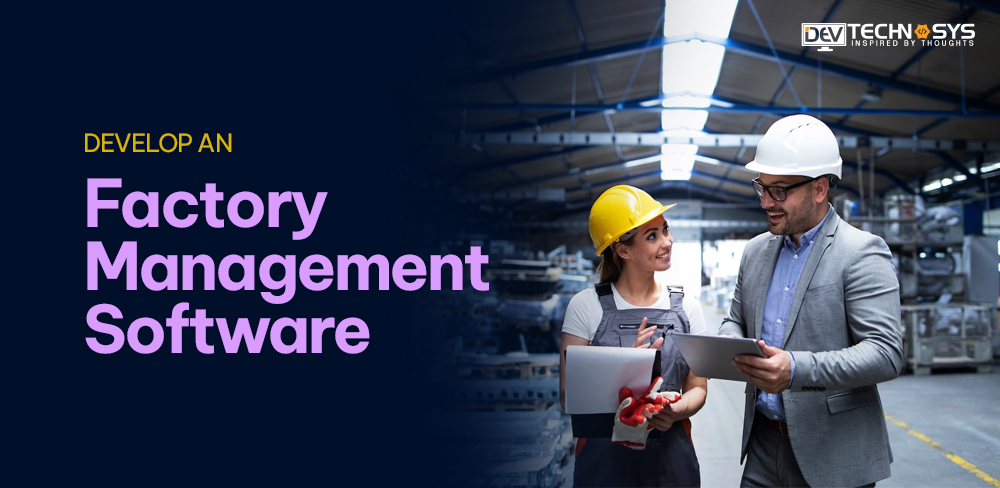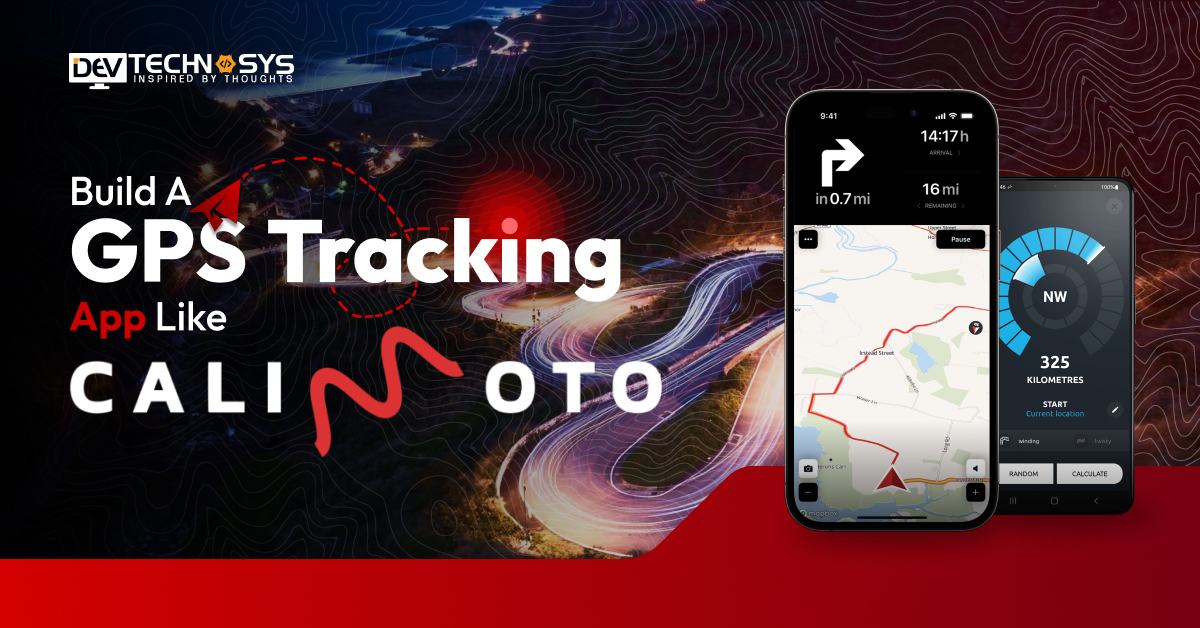Quick Summary: The blog explores the factors influencing the development of factory management software. It covers key considerations such as features, complexity, and technology stack, providing insights for businesses looking to invest in efficient factory management solutions.
Are you looking to develop a factory management software? If yes, dive into this blog to learn more. Advanced software program solutions must often be included to gain robust factory control. In this blog, we will discuss the cost to develop factory management software. The cost of factory management software improves manufacturing, facilitates easy workflow, and optimizes operations in manufacturing settings by navigating the domains of era, customization, and scalability.
Come alongside with us as we delve into the cost to build a factory management software, presenting you with a thorough feature, functions, and many others. So, without wasting time, let’s dive further.
What is Factory Management Software?
A manufacturing facility control software program is a specialized collection of laptop programs created to simplify and enhance a manufacturing facility’s operations.
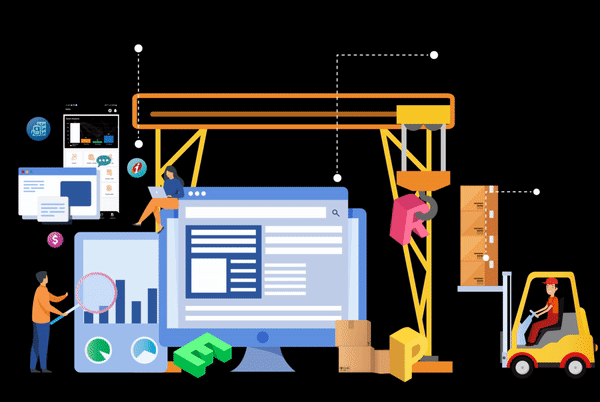
This smart factory management software is vital for coping with many components of production operations, which enables groups to grow production, cut costs, and enhance performance. Key features include Inventory management, manufacturing scheduling, quality assurance, order processing, and resource allocation.
Factory Management Software provides a consolidated platform for monitoring and coping with diverse production aspects by merging many modules and functionalities. It helps communication amongst employees at the production ground, choice-making, and data evaluation in actual time.
These structures often include abilities for managing delivery chains, preserving songs of system renovation, and ensuring adherence to enterprise policies. The major goal is to offer more responsive, agile, and prepared manufacturing surroundings.
How Does Factory Management Software Work?
It integrates several modules and features to optimize and streamline the numerous activities performed inside a smart factory management software development. The following is the working process showcasing ‘How does factory management software work?’
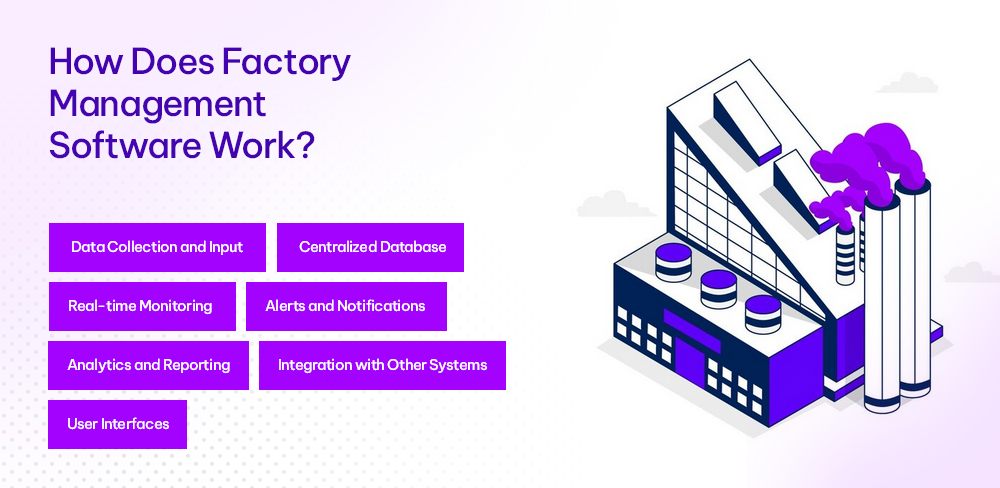
1. Data Collection and Input
The software starts to evolve by using broad statistics from numerous business resources. It includes facts on app statuses, manufacturing schedules, worker movements, and stock levels.
2. Centralized Database
A centralized database boards the accrued facts. All relevant information is centrally located in a single database, facilitating the smooth right of entry for analysis and decision-making.
3. Real-time Monitoring
Various industrial strategies may be watched in real time by using the program. It encompasses keeping tabs on the nation of inventory stages, monitoring production development, and preserving an eye on the circumstances of the equipment.
4. Automation and Control
The AI-based smart factory software may optimize and control precise manufacturing components via its automation capabilities. Processes for excellent manipulation, aid allocation, and automatic scheduling can be problematic.
5. Alerts and Notifications
When predefined parameters are removed, or possible troubles arise, the device will generate indicators and messages. It reduces downtime and permits proactive hassle-solving.
6. Analytics and Reporting
Comprehensive analytics features in manufacturing unit management software allow the user to create reviews and look at previous records. It enables the discovery of patterns, manner optimization, and facts-driven decision-making.
7. Integration with Other Systems
Many manufacturing unit control systems may be integrated with other organizational structures, like CRM (client courting management) and ERP (business helpful enterprise resource planning), to ensure the company’s clean information flow and communication.
8. User Interfaces
The smart factory management app makes it simple for many stakeholders to engage with the device and production managers, operators, and directors by providing user-pleasant interfaces.
8 Major Factors that Affect the Cost to Develop a Factory Management Software
The cost to develop a factory management software involves practical, technological, and strategic variables that must be carefully considered. Let’s have a look at the 8 essential factors that affect the cost to develop a factory management software.
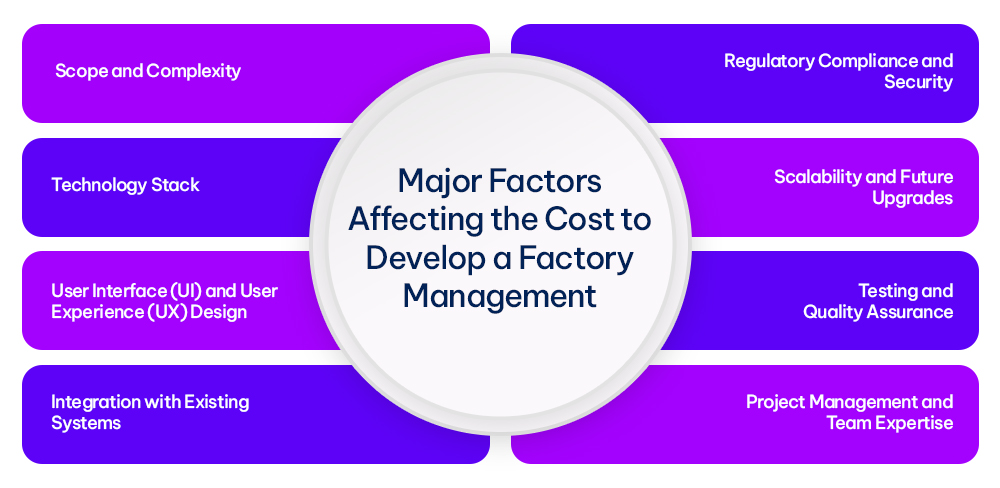
1. Scope and Complexity
One crucial factor that affects the cost to develop a factory management software is its complexity and scope. The cost of a more targeted solution may inevitably be decreased than that of a comprehensive system with a wide range of skills, like manufacturing, making plans, inventory management, exceptional management, and maintenance tracking.
The complexity of those capabilities can also impact the cost of developing factory management software, the degree of customization desired, and critical integration. Scope creep may be avoided throughout the software product development method by having a nicely defined scope with precise requirements that could help control costs.
2. Technology Stack
The selection of a technology stack significantly affects the cost to develop a factory management software. The databases, frameworks, and programming languages selected could considerably affect how lengthy and what kind of work it takes to assemble something.
Selecting a manufacturing software development company will help you choose the widely supported and broadly used technologies that could save money on persevering with maintenance and development time. However, because specialized knowledge is needed, costs might boom if positive functions are named for specialized technologies.
3. User Interface (UI) and User Experience (UX) Design
For personal adoption and productivity, the manufacturing facility management software’s UI/UX design is an essential factor that affects the overall cost of developing factory management software. Productivity may be undoubtedly impacted through an intuitive interface that considers consumer workflows.
However, creating and executing a successful UX/UI requires more painting, expertise, and testing. The degree of customization, the requirement for responsive layout, and accessibility concerns all move into the final cost of automotive software development.
4. Integration with Existing Systems
Systems like Manufacturing Execution Systems (MES), Enterprise Resource Planning (ERP), and legacy software programs are already in place in lots of companies.
The cost to develop factory management software may be significantly impacted by how tough it is to integrate with those cutting-edge ones. Hire software developers and perform careful planning and compatibility analyses, and sometimes, introducing specialized connectors or middleware is necessary for seamless integration.
5. Regulatory Compliance and Security
Regulations and requirements for the enterprise must be adhered to using a factory management software program. Two crucial elements that affect the cost to develop factory management software are following and setting strong security measures in locations to steady sensitive facts.
To protect against cyber risks, the startup app development company may need to allocate a more significant cost range for encrypting information, completing compliance exams, and following excellent practices.
6. Scalability and Future Upgrades
The software program must evolve and adapt to the manufacturing unit surroundings within the destiny. When making plans for scalability, one must bear in mind the gadget’s ability to deal with developing information volumes, person counts, and feature units.
Creating a system without problems, upgraded and advanced, can also lower the entire factory management software development cost of possession through the years. Ignoring scalability ought to cause rework or redevelopment when the manufacturing unit grows or changes.
7. Testing and Quality Assurance
Thorough trying out is essential to guarantee the manufacturing unit control software program’s dependability and functionality. Testing efforts may be impacted by the complexity of the software, the number of features, and the requirement for interoperability across many structures and gadgets.
To locate and connect troubles early in the supply chain management software development lifecycle, excellent guarantee processes, unit checking out, integration trying out, and person acceptability trying out is critical. A comprehensive trying-out procedure can reduce the cost to develop a factory management software.
8. Project Management and Team Expertise
Efficient project control is essential to retaining cost manipulation and ensuring transport is on schedule. The level influences the pace and caliber of the warehouse management software development company, including programmers, machine architects, and area experts.
While hiring dedicated developers may cost more, their experience can bring about extra effective factory management system software development and fewer mistakes, boosting long-term cost-effectiveness.
What is the Determined Cost To Develop a Factory Management Software?
The cost to develop supply chain management software may vary on various standards, software size, capability, tech stacks, complexity, and other related features. Nevertheless, the cost to develop a factory management software ranges from $8,000 to $30,000 in the past.
On the other hand, hiring a leading mobile app development company to develop a factory management software might be moderately expensive. For a fair cost, you can employ expert developers to assist you in developing factory management software.
|
Development Complexity |
Cost Range |
| Simple App Development | $8,000 – $16,000 |
| Average App Development | $16,000 – $25,000 |
| Complex App Development | $25,000+ |
Thus, this is simply a tabular cost estimate for the smart factory management application development. Contact the best mobile app development company if you want more cost information to develop factory management software.
How To Reduce the Cost to Develop Factory Management Software?
Factory Management Software development may be made less expensive using a strategic technique that includes careful planning, aid optimization, and intelligent use of the era. We’ll move over some processes on these outstanding factors that will help you cut the cost to develop factory management software.
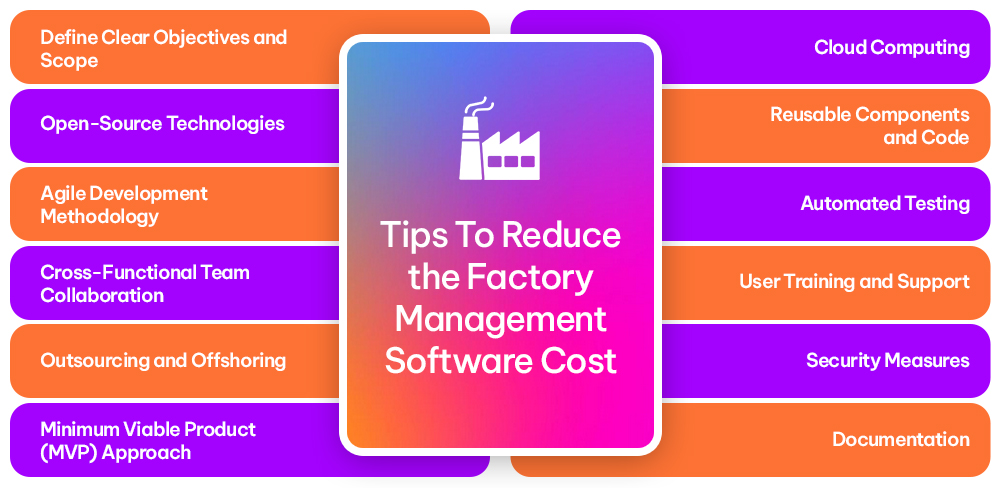
1. Define Clear Objectives and Scope
Discover the desires and scope of your AI-based smart factory software development before you begin growing. Determine the essential functions and functionalities for the smooth operation of your enterprise. By doing this, scope missing and unachievable goals could be prevented so that it will, in the end, save cost to develop factory management software.
2. Open Source Technologies
Use open-supply technologies to cut down on the cost of asset-tracking software development. Several reliable frameworks and libraries are accessible, which saves money and time. Python, Django, and Ruby on Rails are systems that may speed up development without compromising excellence.
3. Agile Development Methodology
Use an agile development technique to improve responsiveness and flexibility. You can make changes with this iterative strategy, which lowers the opportunity of the high cost to develop factory management software closer to the end of the development cycle.
4. Cross-Functional Team Collaboration
Encourage cross-functional teams to collaborate. Optimistic commercial enterprise analysts, software development companies, and architects collaborate intently to foster efficient conversation. As a result, the development technique moves more quickly, and there are fewer chances of mismanagement and rework.
5. Outsourcing and Offshoring
Consider hiring custom software development company components to locations with cheaper developers costs or outsourcing non-centre development. It can store an extraordinary deal without sacrificing quality. On the other hand, make sure you and your outsourcing partner have clean lines of communique and exact procedures.
6. Minimum Viable Product (MVP) Approach
Put a Minimum Viable Product (MVP) plan into movement. Concentrate on developing crucial features that fulfill present-day demands and create value. It reduces the needless cost of custom software development by enabling you to launch the program swiftly, get consumer input, and determine future development.
7. Cloud Computing
Accept cloud computing offerings like Microsoft Azure and Amazon Web Services (AWS). Because of its scalability and capability to take away substantial upfront hardware costs, you can pay for assets as you use them. Additionally, cloud services minimize ongoing running costs via streamlining enhancements and maintenance.
8. Reusable Components and Code
Promote the creation of code modules and reusable parts. In addition to accelerating development, this lowers the possibility of mistakes. Reusable elements provide uniformity among numerous manufacturing facility control software program sections and save time in subsequent tendencies.
9. Automated Testing
The AI development company will review the bugs at the beginning of the development procedure to locate and address problems. Doing this would ensure a better-quality product and lower the cost of bug fixes afterwards inside the development procedure. Tools for computerized checking out and non-stop integration can be included in the development manner to increase productivity.
10. User Training and Support
Create thorough training materials and offer consumer assistance to reduce troubles after release. A user base with proper schooling is less likely to run into problems, lowering the need for non-stop maintenance and support. Proactive measures can keep cash in the long run.
11. Security Measures
Throughout the warehouse management software development process, deliver security pinnacle priority to save you high-costs security breaches. Adopt steady coding strategies, carry out frequent safety audits, and hold up with the maximum current security dangers. Proactively addressing safety problems decreases the probability of high-cost safety incidents and their aftereffects.
12. Documentation
At some stage in the development segment, all hold targeted documentation. CRM development companies can understand and regulate software more quickly and cheaply. At the same time, it has appropriately documented code and device structure, saving money and time when future development or troubleshooting is needed.
7 Ways To Get Maximum ROI On Your Cost To Develop Factory Management Software
Adopting powerful and simplified factory control software is critical for enhancing productivity, reducing costs, and guaranteeing standard operational excellence in ultra-modern, fast-converting commercial scenes.
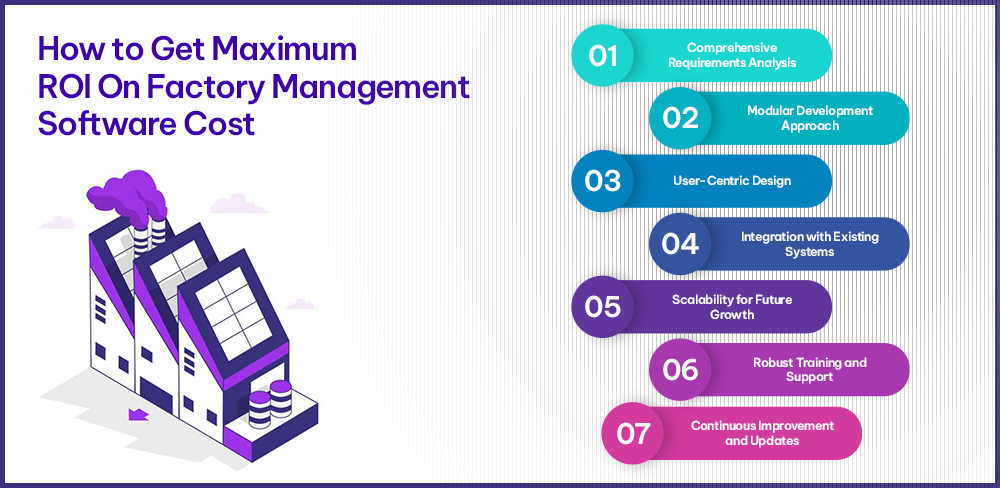
However, such software development return on funding (ROI) determines its success. Take into account the following seven procedures to ensure the first-class return on your investment even as a growing factory control software program.
1. Comprehensive Requirements Analysis
Perform a complete examination of your manufacturing facility’s unique requirements and difficulties before beginning the improvement manner. To decide needs and pain regions, engage with vital stakeholders, inclusive floor operators, and production managers.
A thorough draw close of the unique necessities of your business enterprise will be a helpful resource within the best inventory management software, keeping off more excellent functions that would enhance costs without providing cost.
2. Modular Development Approach
Select a modular yard management software development strategy to divide this system into more possible smaller components. It makes it viable for your team to expand incrementally and prioritizes delivering vital functions first. By enforcing an agile method, you may react swiftly to changing necessities and ensure the software program works together with your changing business tactics.
3. User-Centric Design
Make consumer experience (UX) layout a pinnacle precedence to ensure the program is easy to use and intuitive. A nicely designed interface minimizes errors and lowers operators’ learning curve, increasing manufacturing base productivity.
Throughout the POS software development method, do the person checking out to enter and make required modifications so that customers’ wants and possibilities are met by using the final software.
4. Integration with Existing Systems
You could boost its interoperability by easily integrating your manufacturing smart factory solution with existing programs, such as chain management, ERP, and stock management.
By disposing of organizational silos and lowering the opportunity for mistakes, this integration optimizes records gliding all through the business enterprise. An integrated app gives a complete view of activities and will increase performance.
5. Scalability for Future Growth
Create the software program with scalability in thoughts to fulfill your manufacturing unit’s expanding and evolving desires. This ensures that the preliminary software development investment will continue to pay off after your corporation grows. A scalable solution eliminates the need for a complete device redecorating by making it easy to incorporate new capabilities, modules, or technologies.
6. Robust Training and Support
Provide finances for in-depth schooling courses and continuing assistance to allow your workforce to apply the brand-new software efficiently. Users with sufficient schooling are much more likely to benefit from the IoT app development complete capability, which boosts output and expedites return on funding. Update education materials regularly to live on top of things with new software features and changing industry first-rate practices.
7. Continuous Improvement and Updates
Adopt a continuous development method that carries daily updates and improvements based on consumer input and technology tendencies. Your factory management software keeps its cost over time by proactively resolving troubles and adding beneficial capabilities. Frequent enhancements additionally guarantee that the program complies with security guidelines and enterprise standards.
How Much Does It Cost To Maintain Factory Management Software?
Mobile App Maintenance Services for manufacturing facility management software commonly amount to 15–25% of the development cost, ranging from $8,000 to $25,000. For example, the maintenance cost of a mobile app yearly varies from $3,000 to $4,000 if software program development costs are $20,000. Technical assistance, bug fixes, and updates are all protected in maintenance costs.
Regular preservation makes this system safe and effective. For further statistics and individualized guidance, please get in touch with our knowledgeable group of developers at Dev Technosys. We can offer customized solutions and insights into your unique wishes. To study more excellent security alternatives and enhance your manufacturing unit management software program, contact our Dev Technosys team.
Ready To Develop Factory Management Software With Dev Technosys?
Hello there! We are undoubtedly happy to have labored with you in your Factory Management Software mission. Dev Technosys presents an abundance of pleasure, innovative hassle-fixing, and a dedication to excellence. Our dedicated developers are ready to assess business requirements, offer progressive software programs, and create solutions that are particularly tailor-made to you.
Together, the permits outlined in this channel ensure the most desirable performance and seamless commercial enterprise operations. If you share a little more information with us, we will develop a response that surpasses your expectations.
Frequently Asked Questions
Q1. How Much Does Factory Management Software Development Cost?
Complications and features impact the cost to develop a factory management software. While complex solutions cost $25,000, a simple app may cost around $8,000. Customization, the technological stack, and the development team all boost costs.
Q2. How Much Time Does it Take to Create Software For Factory Management?
The development time may range from six to twelve months, depending on the capabilities, complexity, and degree of customization. Agile strategies can expedite the manner, sparking off delivery and non-stop development.
Q3. What Advantages Does the Development of Factory Management Software Offer?
The fundamental benefits include better output, decreased costs, facts-pushed decision-making, simplified tactics, real-time tracking, and more desirable efficiency. It encourages adaptability, sustainability, and compliance, all assisting universal industrial enterprise success.
Q4. Why Should You Choose Us to Develop Factory Management Software?
At Dev Technosys, we guarantee a customized solution to fit your particular requirements. We stand out with knowledgeable developers, open strains of communication, and a consumer-centered philosophy. Anticipate a robust, expandable, and future-proof system.
Q5. How Can You Monetize a Factory Management Software?
Monetize your app in step with consumer costs, subscription fashions, and licensing. There are approaches to making money from more significant services, including customization, schooling, and continuous help. Various clients are drawn in by supplying characteristic-wealthy and expandable solutions.
